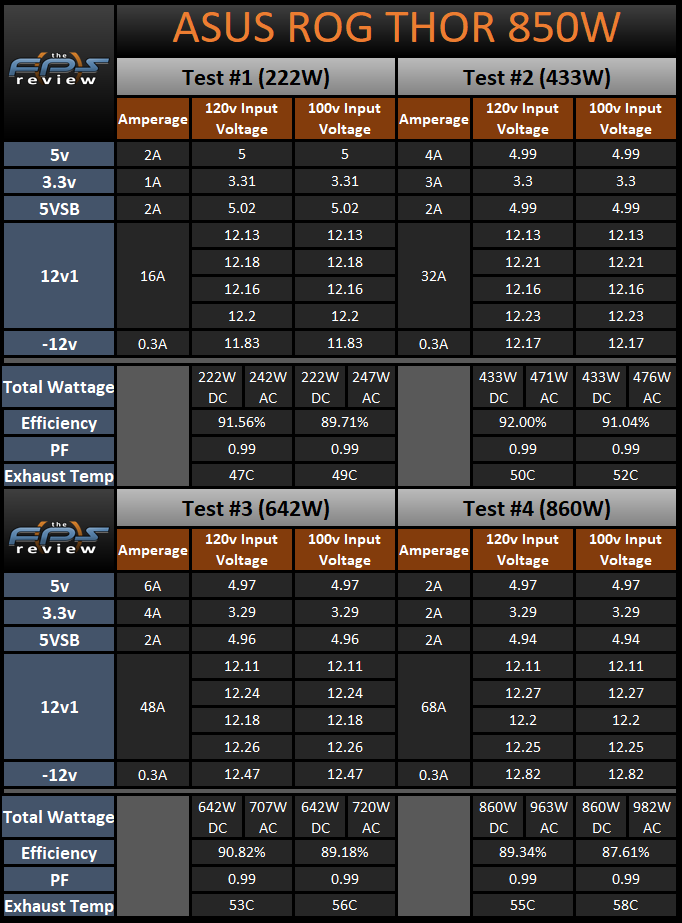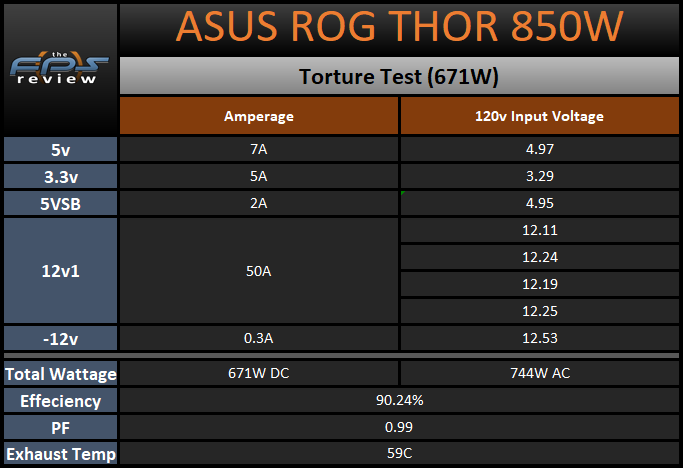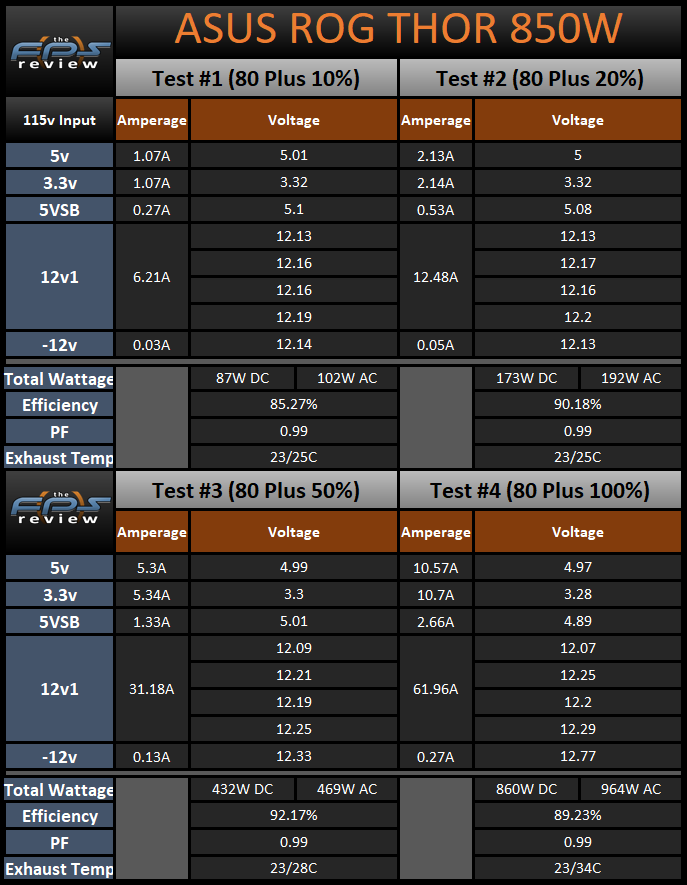Load Testing
For those of you that are curious as to some of the reasoning and equipment behind our PSU testing program here at TheFPSReview, we have put together an introduction for you. This program is based on what the author developed at [H]ardOCP and utilizes the equipment bequeathed to the author by Kyle Bennett. The testing we are conducting today is exactly as described in that document and start with our 120v, 100v, Torture, and 80 Plus Tests.
120v and 100v Load Testing Results

Test #1 is equal to approximately 25% of the rated capacity of the ASUS ROG THOR 850W at 45c. This makes Test #1 equal to 222W by loading the 12v rail to 16a, the 5v rail to 2a, the 3.3v rail to 1a, the +5vsb to 2a, and the -12v to 0.3a. The results of Test #1 show the main positive DC output rails starting at or above nominal. The efficiency for this unit is starting off in excellent shape at a value of 91.56% at 120v AC input and 89.71% at 100v AC input. We see the exhaust temperature is 47C at 120v AC input and 49C at 100V AC input.
Test #2 is equal to approximately 50% of the rated capacity of the ASUS ROG THOR 850W at 45c. This makes Test #2 equal to 433W by loading the 12v rail to 32a, the 5v rail to 4a, the 3.3v rail to 3a, the +5vsb to 2a, and the -12v to 0.3a. Test #2 sees mixed results in DC output voltages relative to what we saw with Test #1. The largest changes are up to a 0.03v increase on the 12v rail and a 0.01v drop on the 5v and 3.3v rails. The efficiency has barely moved up to 92.00% at 120v AC input and 91.04% at 100v AC input. We see an exhaust temperature of 50C at 120v AC input and 52C at 100V AC input.
Test #3 is equal to approximately 75% of the rated capacity of ASUS ROG THOR 850W at 45c. This makes Test #3 equal to 642W by loading the 12v rail to 48a, the 5v rail to 6a, the 3.3v rail to 4a, the +5vsb to 2a, and the -12v to 0.3a. Test #3 sees slightly mixed changes. The 5v and 3.3v rails have dropped by up to 0.02v. The 12v rail has increased by up to 0.03v. The efficiency in Test #3 moves down to 90.82% at 120v AC input and 89.18% at 100v AC input. We see an exhaust temperature of 53C at 120v AC input and 56C at 100V AC input.
Test #4 is equal to approximately 100% of the rated capacity of the ASUS ROG THOR 850W at 45c. This makes Test #4 equal to 860W by loading the 12v rail to 68a, the 5v rail to 2a, the 3.3v rail to 2a, the +5vsb to 2a, and the -12v to 0.3a. In the final regular test, we see the 12v rail move up by up to 0.03v. The minor rails, however, see no change. The efficiency has dropped as we see it come in at 89.34% at 120v AC input and 87.61% at 100v AC input. We see an exhaust temperature of 55C at 120v AC input and 58C at 100V AC input.
Torture Test

The Torture Test is equal to approximately 80% of the rated capacity of the ASUS ROG THOR 850W at 45C. This makes the Torture Test equal to 671W by loading the 12v rail to 50a, the 5v rail to 7a, the 3.3v rail to 5a, the +5vsb to 2a, and the -12v to 0.3a. At the end of the Torture Test, the ROG THOR 850W is still doing well. The DC output voltages are generally in line with what we have been seeing in the 120v load tests. The efficiency is excellent as we see a value of 90.24% and the exhaust temperature is 59C.
80 Plus Load Testing Results

As we see here, the ROG THOR 850W posts efficiency values of 90.18%-92.17%-89.23% using 80 Plus’ load testing parameters. This puts the unit right in the 80 Plus Platinum standard. However, we do use different equipment than 80 Plus for our testing and there is always a bit of component variation.
Load Testing Summary
Today, the ASUS ROG THOR 850W did an excellent job in our initial load testing. When we look at the voltage regulation, we see that the ROG THOR 850W had peak changes of 0.09v on the 12v rail, 0.03v on the 5v rail, and 0.02v on the 3.3v rail. These absolute values are easily in the specification and this unit is mixed in relation to the excellent Enermax REVOLUTION DF 850W we just reviewed. These excellent results extend to the efficiency as it ranged from 89.34% to 92.00% efficient at 120v AC input and 87.61% to 91.04% efficient at 100v AC input. Unsurprisingly then, this unit also made the advertised 80 Plus efficiency values easily. Lastly, the exhaust temperature peaked at 55C at 120v AC input, 58C at 100v AC input, and 59C during the Torture Test. With excellent starting results in today’s testing, let’s move on to the Transient Load Tests.
